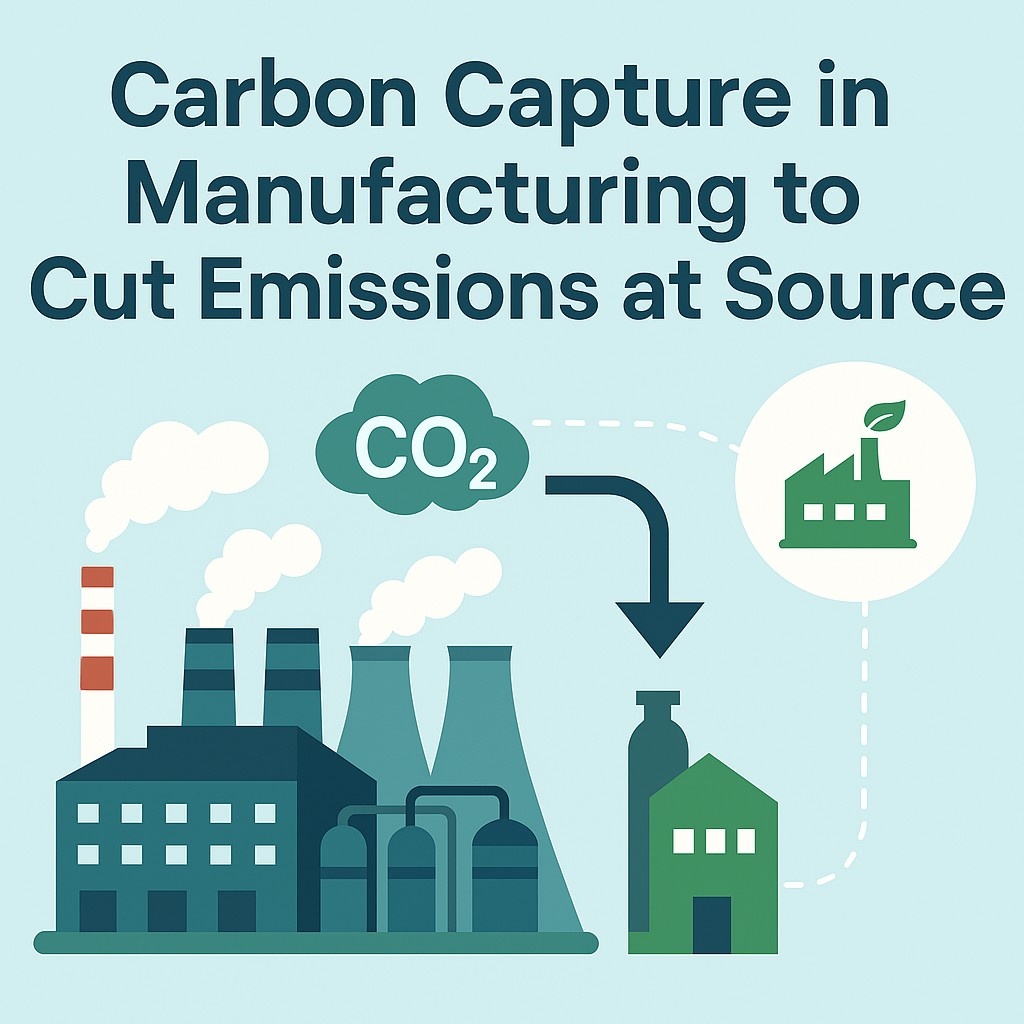Carbon Capture and Utilization: A Vital Technology for Reducing the Carbon Footprint in Manufacturing

As global emissions rise and climate targets tighten, the manufacturing sector faces mounting pressure to transition toward sustainable production. Industrial processes account for approximately 25% of global CO₂ emissions, making decarbonization a top priority.
Among the many emerging solutions, carbon capture and storage (CCS) stands out as a critical technology to reduce emissions at the source. By preventing CO₂ from entering the atmosphere and enabling its reuse or safe storage, CCS plays a transformative role in mitigating the carbon footprint in manufacturing. Combined with low-carbon technologies, it offers a viable path to climate-aligned growth without compromising productivity.
What is Carbon Capture and Storage (CCS)?
Carbon capture and storage (CCS) refers to a set of technologies that capture carbon dioxide emissions from industrial sources, transport it, and either store it underground or repurpose it for industrial use. The process typically includes three stages:
- Capture: CO₂ is separated from exhaust gases using solvents, membranes, or solid sorbents.
- Transport: The captured CO₂ is compressed and transported via pipelines, ships, or trucks to storage or utilization sites.
- Storage or Utilization: The CO₂ is injected into geological formations (like depleted oil fields) for permanent storage or converted into value-added products such as fuels, chemicals, or building materials.
As a scalable solution, CCS is particularly relevant for hard-to-abate sectors like steel, cement, and chemicals where emissions are process-related and cannot be eliminated through energy transition alone.
The Role of Carbon Capture Technology in Manufacturing
In manufacturing, carbon capture technology offers a way to retrofit existing plants to comply with stricter environmental norms. Rather than requiring a complete redesign, CCS systems can be integrated into current processes, especially in emissions-heavy facilities. Technologies such as post-combustion capture and oxy-fuel combustion allow manufacturers to intercept CO₂ before it enters the atmosphere.
Emerging approaches also use AI and digital twins to optimize capture efficiency, reducing energy penalties traditionally associated with CCS systems. As more manufacturers adopt carbon intensity metrics in their reporting, carbon capture technology is becoming essential for maintaining competitiveness and regulatory compliance.
How Carbon Capture Helps in Reducing the Carbon Footprint in Manufacturing
One of the most direct applications of CCS is its role in reducing the carbon footprint associated with manufacturing activities. Emissions from raw material processing, thermal treatment, and chemical reactions are captured before release, significantly lowering a facility’s environmental impact. Unlike carbon offsets, which compensate for emissions elsewhere, CCS addresses the problem at its origin.
Additionally, when captured CO₂ is utilized to produce low-carbon fuels or synthetic materials, it contributes to circular economy goals. As lifecycle emissions are reduced, products manufactured with CCS integration gain an advantage in markets increasingly guided by ESG standards.
Low-Carbon Technologies: The Path to Sustainable Manufacturing
Low-carbon technologies include a range of innovations that reduce greenhouse gas emissions across the value chain. Carbon capture is often deployed alongside these advancements to achieve deeper decarbonization:
- Electrification of Heat Processes: Switching from fossil fuels to electric-powered kilns and furnaces.
- Green Hydrogen Substitution: Using hydrogen produced via renewable energy in chemical and metallurgical processes.
- Energy Efficiency Improvements: AI-based controls, real-time monitoring, and predictive maintenance.
- Waste Heat Recovery Systems: Capturing and reusing thermal energy from industrial processes.
Together, CCS and low-carbon technology enable a comprehensive transition strategy, addressing both direct and indirect emissions.
Benefits of Carbon Capture and Utilization in Manufacturing
Implementing carbon capture and utilization in manufacturing delivers multiple advantages:
- Regulatory Readiness: CCS helps industries meet current and future emission standards.
- Operational Flexibility: Can be applied to existing plants without complete overhauls.
- Brand Reputation: Enhances corporate sustainability credentials, aiding stakeholder trust.
- Revenue Streams: Captured CO₂ can be converted into fuels, plastics, and even cement, creating circular economic value.
- Climate Impact: Directly reduces CO₂ emissions from manufacturing’s most intensive sources.
Get tailored sustainability solutions to support your carbon capture goals and help accelerate your journey to net-zero compliance. Discover how!
Challenges and Opportunities in Implementing Carbon Capture Technology
While CCS offers significant benefits, its adoption comes with challenges:
- High Capital Costs: Installation and retrofitting require substantial upfront investment.
- Energy Demand: Traditional capture processes increase the plant’s energy needs.
- Storage Limitations: Geographical access to viable storage sites varies regionally.
- Policy Gaps: Inconsistent regulatory support and carbon pricing mechanisms.
However, opportunities are expanding. Public-private partnerships, government incentives, and evolving carbon markets are helping scale carbon capture technology. R&D is lowering costs through modular systems and next-gen absorbents, making CCS more accessible for mid-sized manufacturers.
Conclusion
As manufacturers confront the dual pressures of climate responsibility and industrial productivity, carbon capture and utilization emerge as critical tools in the transition. When combined with low-carbon technologies, CCS can significantly lower the carbon footprint in manufacturing, enabling compliance, resilience, and competitive advantage.
Ingenero enables industrial decarbonization by integrating carbon mitigation strategies, advanced process analytics, and real-time monitoring solutions. With tailored sustainability-focused services, Ingenero helps manufacturers deploy practical pathways for emissions reduction, operational optimization, and long-term regulatory readiness.
With carbon regulations tightening and markets shifting toward greener supply chains, the strategic adoption of carbon capture technology is not just an environmental decision but a business imperative. Investing in carbon capture and storage today positions manufacturers for success in a decarbonized economy tomorrow.
FAQs
Carbon capture technology in manufacturing captures CO₂ emissions directly from industrial exhaust streams. The gas is then compressed, transported, and either stored underground or used to create low-carbon products like fuels or building materials.
Low-carbon technologies are innovations that reduce greenhouse gas emissions during industrial operations. These include electrification, green hydrogen, energy efficiency systems, carbon capture, and circular economy practices that lower the overall environmental impact of manufacturing.
Reducing the carbon footprint in manufacturing improves regulatory compliance, strengthens brand reputation, unlocks access to green financing, lowers operating costs over time, and ensures long-term viability in an increasingly sustainability-driven global economy.
Yes, CCS technology can be retrofitted into existing plants using post-combustion or oxy-fuel systems. This allows manufacturers to lower emissions without redesigning the entire production setup, making decarbonization more accessible and scalable.



